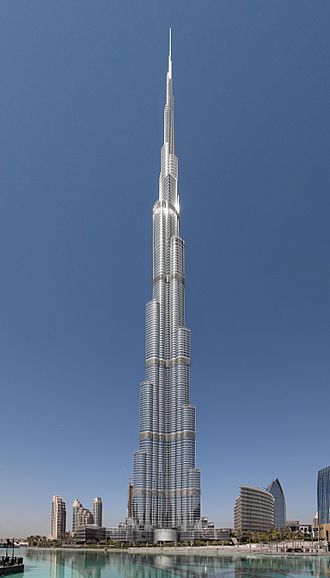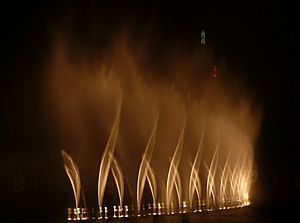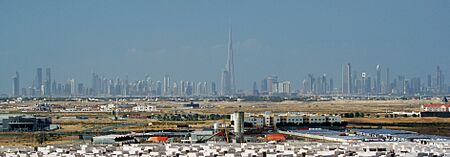Burj Khalifa facts for kids
Quick facts for kids Burj Khalifa |
|
|---|---|
|
برج خليفة
|
|

Viewed across The Dubai Fountain
|
|
| Former names | Burj Dubai |
| Record height | |
| Tallest in the world since 2009 | |
| Preceded by | Taipei 101 |
| General information | |
| Status | Completed |
| Type | Mixed-use |
| Architectural style | Neo-futurism |
| Location | Dubai |
| Address | 1 Sheikh Mohammed bin Rashid Boulevard |
| Country | United Arab Emirates |
| Coordinates | 25°11′49.7″N 55°16′26.8″E / 25.197139°N 55.274111°E |
| Named for | Sheikh Khalifa |
| Construction started | 6 January 2004 |
| Topped-out | 17 January 2009 |
| Completed | 1 October 2009 |
| Opened | 4 January 2010 |
| Cost | US$1.5 billion |
| Owner | Emaar Properties |
| Height | |
| Architectural | 828 m (2,717 ft) |
| Tip | 829.8 m (2,722 ft) |
| Top floor | 584.5 m (1,918 ft) |
| Observatory | 555.7 m (1,823 ft) |
| Technical details | |
| Structural system | Reinforced concrete, steel, and aluminium |
| Floor count | 154 + 9 maintenance |
| Floor area | 309,473 m2 (3,331,100 sq ft) |
| Lifts/elevators | 57 |
| Design and construction | |
| Architect | Adrian Smith |
| Architecture firm | Skidmore, Owings & Merrill |
| Structural engineer | Bill Baker |
| Main contractor | Samsung C&T |
| Other information | |
| Parking | 2 subterranean levels |
Burj Khalifa (Arabic: برج خليفة, "Khalifa Tower") is a skyscraper in Dubai, United Arab Emirates and is the tallest building ever built, at 828 metres (2,717 feet). Before the building opened, it was called Burj Dubai. The building is 162 stories high. Construction of the tower was started in 2004. The building was officially opened on 4 January 2010. It is the tallest structure made by humans in the world. The building is more than 300 metres (980 feet) taller than Taipei 101. Taipei 101 was the tallest building until 2010 before Burj Khalifa was built.
Adrian Smith designed the tower. He worked with Skidmore, Owings and Merrill (SOM) until 2006. It was built by Samsung Engineering & Construction, Besix, and Arabtec. The tower cost US $1.5 billion to build. The building is part of a 2 kilometres (1.2 miles) building project on Sheikh Zayed Road, Downtown Burj Khalifa. It is near Dubai's main business district.
Contents
The building and planning
The main contractor was Samsung C&T of South Korea. They also built the Taipei 101 and Petronas Twin Towers. Other contractors who helped with the building included Belgian group Besix and Arabtec from the UAE. The Turner Construction Company was chosen as the construction project manager.
The design architect, Adrian Smith, did not like the first design of the upper part of the building. He added 27 new floors and an aluminium spire to the top of the plans. The design of Burj Khalifa based on those used in Islamic architecture. Burj Khalifa has been said to have had several other planned height increases since it was first built. This has not been proven to be true yet. The TV/radio communications mast was added to the tower's plans in 2007. This was after building work had begun in 2006. There are pressurized, air-conditioned refuge floors about every 35 floors. These were put into the tower in case of an emergency or fire.
The unusual design and engineering problems of building Burj Khalifa have been shown in many television documentaries. These include the Big, Bigger, Biggest series on the National Geographic and Five channels, and the Mega Builders series on the Discovery Channel.
The most important building material of Burj Khalifa is reinforced concrete. A special concrete was needed because of the high pressures of the building's weight and the hot local climate of Persian Gulf temperatures that can reach 50 °C (122 °F). Any major cracks could have caused a large amount of damage to the building.
The foundation of the building is 15 metres (49 feet) deep. It was built with 192 columns being put into the ground. Each column was 1.5 metres (4 feet 11 inches) in diameter and 43 metres (141 feet) long. 55,000 tonnes (121,000,000 pounds) of steel rebar was used in the construction of the tower. It took 22 million man-hours to build. A high density, low permeability concrete was used in the foundations of Burj Khalifa. A cathodic protection system is used to lessen any bad effects from corrosive chemicals in local ground water.
The Dubai Fountain
A fountain system was built outside the tower. It was designed by WET Design of California. They built and planned out the fountains at the Bellagio Hotel Lake in Las Vegas. The fountain cost UAEd 800 million. It is lit by 6,600 lights and 50 coloured projectors. The fountain is 84 metres (275 feet) long. It shoots water 46 metres (150 feet) into the air to the sounds of classical and modern Arabic and world music. On 26 October 2008, the fountain was named the Dubai Fountain.
Delays and late building work
Emaar Properties said on 9 June 2008 that construction of Burj Khalifa was slowed because of changes to finishes. An Emaar official said that the luxury finishes that were decided on in 2004, when the tower was first planned, were being being replaced by better finishes. The design of the apartments were also made better. This was done to make them both look better and work better. There were problems with the marble decorations, flooring, the top floors' sanitation system, broken glasswork and a poorly done wall mural of the Sultan of Oman. A new ending date of 2 December, 2009, was then given. Burj Khalifa opened on 4 January 2010.
Workers' disputes and strikes.
Burj Khalifa was built mainly by people from South Asia. Press reports said in 2006 that skilled carpenters at the site earned UK£4.34 a day, and labourers earned UK£2.84. According to a BBC investigation and a Human Rights Watch report, the workers lived in very bad conditions. Often they were not paid for the work. Their passports were taken by their employers. It was said that they were working in dangerous conditions that caused high number of deaths and injuries. Companies not paying workers has been reported to the authorities several times.
On 21 March 2006, about 2,500 workers protested. They were mad about buses that were delayed for the end of their shifts. They damaged cars, offices, computers, and construction equipment. A Dubai Interior Ministry official said they caused almost UK£500,000 in damage. Most of the workers who were part of the riot returned the following day but would not work.
Milestones
- January 2004: Excavation commences.
- February 2004: Piling starts.
- 21 September 2004: Emaar contractors begin construction.
- March 2005: Structure of Burj Khalifa starts rising.
- June 2006: Level 50 is reached.
- February 2007: Surpasses the Sears Tower as the building with the most floors.
- 13 May 2007: Sets record for vertical concrete pumping on any building at 452 m (1,483 ft), surpassing the 449.2 m (1,474 ft) to which concrete was pumped during the construction of Taipei 101, while Burj Khalifa reached the 130th floor.
- 21 July 2007: Surpasses Taipei 101, whose height of 509.2 m (1,671 ft) made it the world's tallest building, and level 141 reached.
- 12 August 2007: Surpasses the Sears Tower antenna, which stands 527 m (1,729 ft).
- 12 September 2007: At 555.3 m (1,822 ft), becomes the world's tallest freestanding structure, surpassing the CN Tower in Toronto, and level 150 reached.
- 7 April 2008: At 629 m (2,064 ft), surpasses the KVLY-TV Mast to become the tallest human-made structure, level 160 reached.
- 17 June 2008: Emaar announces that Burj Khalifa's height is over 636 m (2,087 ft) and that its final height will not be given until it is completed in September 2009.
- 1 September 2008: Height tops 688 m (2,257 ft), making it the tallest human-made structure ever built, surpassing the previous record-holder, the Warsaw Radio Mast in Konstantynów, Poland.
- 17 January 2009: Topped out at 829.8 m (2,722 ft).
- 1 October 2009: Emaar announces that the exterior of the building is completed.
- 4 January 2010: Burj Khalifa's official launch ceremony is held and Burj Khalifa is opened. Burj Dubai was renamed Burj Khalifa in honour of the President of the UAE and ruler of Abu Dhabi, Sheikh Khalifa bin Zayed al Nahyan.
- 10 March 2010: Council on Tall Buildings and Urban Habitat certifies Burj Khalifa as world's tallest building.
Records
The Burj Khalifa set several world records, including:
- Tallest existing structure: 829.8 m (2,722 ft) (previously KVLY-TV mast – 628.8 m or 2,063 ft)
- Tallest structure ever built: 829.8 m (2,722 ft) (previously Warsaw radio mast – 646.38 m or 2,121 ft)
- Tallest freestanding structure: 829.8 m (2,722 ft) (previously CN Tower – 553.3 m or 1,815 ft)
- Tallest skyscraper (to top of spire): 828 m (2,717 ft) (previously Taipei 101 – 509.2 m or 1,671 ft)
- Tallest skyscraper to top of antenna: 829.8 m (2,722 ft) (previously the Willis (formerly Sears) Tower – 527 m or 1,729 ft)
- Building with most floors: 163 (previously World Trade Center – 110)
- World's highest elevator installation (situated inside a rod at the very top of the building)
- World's longest travel distance elevators: 504 m (1,654 ft)
- Highest vertical concrete pumping (for a building): 606 m (1,988 ft)
- World's tallest structure that includes residential space
- World's highest installation of an aluminium and glass façade: 512 m (1,680 ft)
- World's highest restaurant (At.mosphere): 122nd floor at 442 m (1,450 ft) (previously 360, at a height of 350 m (1,148 ft) in CN Tower)
- World's highest New Year display of fireworks.
- World's largest light and sound show staged on a single building.
Gallery
-
The spire is added along with the TV/radio mast
Awards
In June 2010, Burj Khalifa was the recipient of the 2010 "Best Tall Building Middle East & Africa" award by the Council on Tall Buildings and Urban Habitat. On 28 September 2010 Burj Khalifa won the award for the best project of the year at the Middle East Architect Awards 2010. Awards Chair Gordon Gill, of Adrian Smith + Gordon Gill Architecture, said:
We are talking about a building here that has changed the landscape of what is possible in architecture – a building that became internationally recognized as an icon long before it was even completed. 'Building of the Century' was thought a more apt title for it.
Burj Khalifa was also the recipient of the following awards.
| Year | Award |
|---|---|
| 2012 | Award of Merit for World Voices Sculpture, Burj Khalifa Lobby from Structural Engineers Association of Illinois (SEAOI), Chicago. |
| 2011 | Interior Architecture Award, Certificate of Merit from AIA – Chicago Chapter. |
| Distinguished Building Award, Citation of Merit from AIA – Chicago Chapter. | |
| Interior Architecture Award: Special Recognition from AIA – Chicago Chapter. | |
| Design Excellence Award: Special Function Room. | |
| Excellence in Engineering from ASHRAE (American Society of Heating, Refrigerating, and Air-Conditioning Engineers) – Illinois Chapter. | |
| Outstanding Structure Award from International Association for Bridge and Structural Engineering. | |
| Decade of Design, Presidential Commendation in Corporate Space Small from International Interior Design Association (IIDA). | |
| Decade of Design • Best of Category/Mixed Use Buildings from International Interior Design Association (IIDA). | |
| GCC Technical Building Project of the Year from MEED (formerly Middle East Economic Digest). | |
| Project of the Year from MEED. | |
| 2010 | International Architecture Award. |
| Arab Achievement Award 2010: Best Architecture Project from Arab Investment Summit. | |
| Architecture Award (Mixed Use) Dubai from Arabian Property Awards. | |
| Architecture Award (Mixed Use) Arabian Region from Arabian Property Awards. | |
| International Architecture Award from Chicago Athenaeum. | |
| American Architecture Award from Chicago Athenaeum. | |
| Commercial / Mixed Use Built from Cityscape. | |
| Best Mixed Use Built Development in Cityscape Abu Dhabi. | |
| Skyscraper Award: Silver Medal from Emporis. | |
| Award for Commercial or Retail Structure from Institution of Structural Engineers. | |
| International Architecture Award (Mixed Use) from International Commercial Property Awards. | |
| Special Recognition for Technological Advancement from International Highrise Awards. | |
| Best Structural Design of the Year from LEAF Award. | |
| International Projects Category: Outstanding Project from National Council of Structural Engineers Associations. | |
| Best of What's New from Popular Science Magazine. | |
| Spark Awards, Silver Award. | |
| Excellence in Structural Engineering: Most Innovative Structure from SEAOI. |
Images for kids
-
Cross-section comparisons of various towers, from ground level to top: Burj Khalifa, Taipei 101, Willis Tower, and World Trade Center
See also
 In Spanish: Burj Khalifa para niños
In Spanish: Burj Khalifa para niños





















